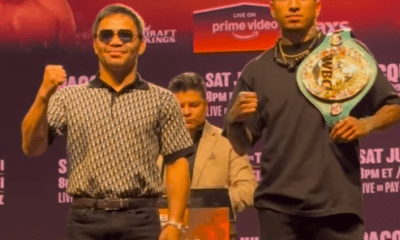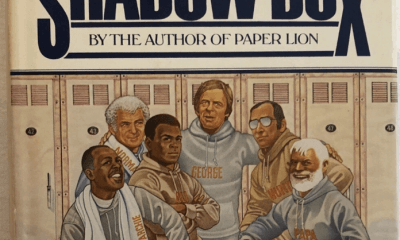Featured Articles
THE HAUSER REPORT: Roc Nation Notes
On Friday night, January 9, Roc Nation Sports made its long-awaited boxing debut in The Theater at Madison Square Garden.
The driving force behing Roc Nation is rap impressario Shawn Carter a/k/a Jay Z.
Jay Z’s entry into the world of boxing began inauspiciously last year when Roc Nation won the purse bid for Peter Quillin’s mandatory WBO title defense against Matt Korobov with a bid of $1,904,840 (more than twice market value). Roc Nation then advised the boxing community that the bout would be contested at Barclays Center in Brooklyn on November 1.
There were two problems with that. First, soon after the bid, New York State Athletic Commission executive director David Berlin advised Roc Nation COO for boxing Dave Itskowitch that the NYSAC would not license Korobov because of a congenital brain condition. Then, while alternative sites were being explored, Quillin gave up the title at the direction of his manager (the ubiquitous Al Haymon), rather than take the fight.
More recently, Roc Nation acquired of Gary Shaw Productions in the hope of benefitting from Shaw’s expertise and also his longtime relationship with HBO Sports president Ken Hershman. On fight day, it announced the signing of Andre Ward to a longterm promotional agreement. But Roc Nation’s fighter roster is pretty thin. And its other flagship fighter, Bryant Jennings, is expected to be eradicated by Wladimir Klitschko on April 25.
The thoughts of rap artist and vitamin-water mogul Curtis Jackson a/k/a 50 Cent are instructive. Last month, Fiddy observed, “When you come into the sport of boxing and have money, you’re steak. To a lot of people, you look like dinner.”
There’s only one chance to make a first impression, so January 9 was important to Roc Nation.
Two days before the event, Itskowitch told writer Tom Gerbasi, “We want to make the in-arena experience more appealing to fans. We want to really amp up the fan experience. I know the fights should do the talking. But there will be other bells and whistles that are going to make things even more enjoyable for fans and keep the fans engaged.”
When fight night arrived, radio personality Angie Martinez was the in-ring hostess. There were a lot of celebrities in attendance. Jay Z, Rihanna, Jake Gyllenhall, C.C. Sabathia, Victor Cruz, DJ Mustard, and Carmelo Anthony were there. Rap artist Fabulos performed for ten minutes before the main event.
The attendance was announced as 4,235, but the house was papered. And rather than give those freebies away as comps, Roc Nation took the unusual step of purchasing them before giving them away. That meant it had to pay an MSG facility fee as well as state and city taxes on each one.
As for the fights; they were essentially club fights.
The six undercard bouts were a mix of bad mismatches and competitive but boring contests. The most notable undercard moment came when light-heavyweight prospect Jerry Odom whacked Andrew Hernandez with two crushing blows. Unfortunately, those blows landed while Hernandez was on the canvas, having taken a knee to recover from a body shot. Odom was appropriately disqualified.
The co-featured fight of the evening pitted sloppy aggression (Tureano Johnson) against all-out retreat (Alex Theran). Sloppy aggression won when the ring doctor stopped the bout after the fifth round.
The main event pitted Arthur “Dusty” Hernandez-Harrison against Tommy Rainone. Harrison, a 20-year-old from Washington DC, is being groomed and protected. Rainone lacks power and came into the bout with 4 knockouts in 28 fights. Four months ago, Tommy fought to a draw against a boxer with a 1-and-2 record. His most recent loss was to an opponent whose record was 2-and-6. Harrison prevailed on the judges’ scorecards by a 100-90, 99-91, 99-91 margin.
Roc Nation lost a lot of money on the show. It costs six figures to open The Theater. Fighters have to be paid, and there were other heavy promotional expenses. Was it an effective loss leader?
The marriage of music and boxing hasn’t been successful in the past. Think HBO’s ill-fated KO Nation and promoter Cedric Kushner’s money-hemorrhaging Thunderbox. It’s not enough to have a ten-minute performance by a popular rap artist before the main event. The fights have to be entertaining too.
* * *
As is often the case on fight night, some of the most interesting happenings were outside the ring.
Freddie Roach worked Chris Van Heerden’s corner during a ten-round, split-decision triumph over Cecil McCalla. Later, Roach had kind things to say about Gennady Golovkin.
“I’ve watched his ring generalship,” Roach told me. “It’s f—–g great. Ring generalship is a lost art, but Golovkin has it. Ninety-five percent of the time, he’s in the right position. If you do that, you win fights. He’s heavy-handed. He’s a nice kid. I’m a big fan.”
Golovkin is the current WBA middleweight champion. Miguel Cotto (who Roach trains) has the WBC belt.
“Golovkin’s people want him to fight Cotto,” Roach noted. “But we want Canelo first.”
How realistic is the possibility that Cotto will fight Golovkin down the road?
“Well,” Roach said, taking a deep breath. “I like fighting fights that people want to see. It would be a huge challenge.”
A challenge that Cotto is unlikely to accept.
* * *
Andre Ward was also at ringside and spoke with reporters.
Ward characterized his contract with Roc Nation as “a blockbuster deal” for a lot of money. An educated guess is that it calls for two fights a year over a five-year period. Unless a television network like HBO bails Roc Nation out, the promoter could lose a lot of money on Andre.
Ward spoke eloquently in favor of elite fighters fighting in big fights and declared, “We can’t say ‘we’ll give the fans what they want,’ and then not compete against each other.”
Then, in the next sentence, Ward said that he’d like to have one or two tune-up fights before going in tough.
* * *
Steve Weisfeld was on hand for the festivities as a judge for the New York State Athletic Commission. That raised the issue of whether there was a conflict of interest between his role at The Theater and his work as a rules expert and unofficial ringside judge for HBO.
The answer is no.
Weisfeld’s contract with HBO expired after the December 6, 2014, telecast featuring David Lemieux vs. Gabriel Rosado and was not renewed.
* * *
And finally . . .
As noted earlier, Roc Nation is a spending a lot of money to break into boxing. One indication of that was the presence of Michael Buffer at ringside.
Buffer is expensive, but his presence makes an event bigger. Earlier in the day, I had lunch with Michael, and he reminisced about a time in his life when he saw Muhammad Ali fairly often.
“We’re talking about 1973, 1974,” Buffer said. “This was way before I got involved in boxing. There wasn’t a thought, an inkling, a clue that I‘d be a ring announcer some day. I was just a fan, living in Lansdale, Pennsylvania, working as a Volkwagen salesman.”
“Lansdale was a 90-minute drive from Deer Lake. One or twice a week when Ali was in training, I’d visit the camp. Deer Lake was open to everyone. The crowds got pretty big. But no matter how many people were there, Ali sat down and signed every autograph that every last person wanted after each sparring session.”
“Larry Holmes was one of Ali’s sparring partners back then,” Buffer continued. “He’d drive up from Easton in a 1965 black Lincoln Continental and was always late, so he was always getting speeding tickets. [Former lightweight champion] Ike Williams hung around. He was broke. Ali would ask him questions about boxing to make him feel important and slip him a few dollars. He gave money to a lot of people.”
“After a while, Ali got used to seeing me around,” Buffer recalled. “Usually, I drove a Volkswagen to the camp. Occasionally, I rode my motorcycle [a Suzuki 550]. One time when I was there, Ali hopped on the bike, rode off, and was gone for an hour. Angelo [trainer Angelo Dundee] was furious at me for giving Ali the motorcycle. He was gone so long, they thought he’d been injured in an accident.”
“And there’s another memory I have that’s special,” Buffer said. “Ali had a couple of magazine covers with his picture on them taped to the wall of the gym. He’d been so nice to me that I wanted to do something for him. So I took the covers off twenty-or-so boxing magazines that I had with his picture on them and brought them to Deer Lake. Ali and I put them up together on the wall. When I think back on that, it’s pretty cool. Me and Muhammad Ali taping magazine covers to the wall of the gym at Deer Lake. And now I’m in the Hall of Fame. Go figure.”
Thomas Hauser can be reached by email at thauser@rcn.com. His most recent book (Thomas Hauser on Boxing: Another Year Inside the Sweet Science) was published by the University of Arkansas Press.
-

 Featured Articles3 weeks ago
Featured Articles3 weeks agoAvila Perspective, Chap. 330: Matchroom in New York plus the Latest on Canelo-Crawford
-

 Featured Articles1 week ago
Featured Articles1 week agoVito Mielnicki Jr Whitewashes Kamil Gardzielik Before the Home Folks in Newark
-

 Featured Articles4 weeks ago
Featured Articles4 weeks agoAvila Perspective, Chap 329: Pacquiao is Back, Fabio in England and More
-

 Featured Articles3 weeks ago
Featured Articles3 weeks agoOpetaia and Nakatani Crush Overmatched Foes, Capping Off a Wild Boxing Weekend
-

 Featured Articles2 weeks ago
Featured Articles2 weeks agoCatching Up with Clay Moyle Who Talks About His Massive Collection of Boxing Books
-

 Featured Articles3 weeks ago
Featured Articles3 weeks agoFabio Wardley Comes from Behind to KO Justis Huni
-

 Featured Articles1 week ago
Featured Articles1 week agoMore Medals for Hawaii’s Patricio Family at the USA Boxing Summer Festival
-

 Featured Articles4 weeks ago
Featured Articles4 weeks agoDelving into ‘Hoopla’ with Notes on Books by George Plimpton and Joyce Carol Oates















